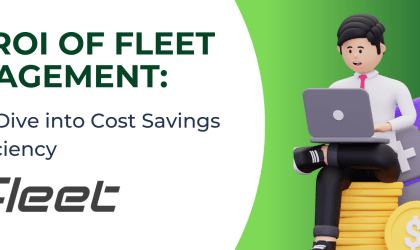Asset Trackers: How Smart Utilization Leads To Efficiency And Cuts On Costs
Today, all businesses including fleets, are trying to rapidly improve their efficiency to cut down on costs and raise productivity. When addressing fleets, many times the asset utilization rate goes unnoticed, and this causes a lack in efficiency that can be avoided.
Smart Utilization
Ensuring that the usage of each asset is maximized but not going overboard is simply called ‘Smart Utilization’. There are several scenarios when assets just catch dust and don’t get utilized because there’s an excess of that asset, and vice versa with ones being over utilized.
Fleets often overlook this strategy making it a critical strategy to review and implement. Doing so will allow fleets to expect to see visibility of finances, unnecessary costs and gaps in maintenance procedures.
What Is The Smart Utilization Strategy
If all assets are tracked based on their utilization rates, fleets can figure out which assets are being under and overused and make decisions accordingly. If assets are being underused, this means there’s an excess of the resource and it’s being wasted. If an asset is overused, this will create maintenance issues with it as it’s being used way too much and will be prone to breaking down. This will provide fleets with the information of how many assets they need to add or remove from their fleet for maximizing efficiency and staying within budget.
Key performance indicators for vehicles include days driven, drive time and mileage while key performance indicators for other assets include operation duration times and location tracking. Fleets can easily view these statistics from their telematics system online.
Smart Benefits of Smart Utilization
By using a smart utilization strategy, fleets actually implement a smart cost management solution because they use all their resources to their maximum capability and get the highest return on investment.
With the additional data on the number of resources required, fleets can ensure there are enough resources to run at maximum efficiency to get the best results in the long run. Since all assets will now be properly used and no longer overused, they will have a long lifespan.
How Smart Utilization Can Be Beneficial
Utilization reports show which assets are hardly used or overused, or in downtime for maintenance or repair. Monitoring this activity will help fleets improve on replacement cycling and will also quickly point out areas of opportunity to re-deploy vehicles into other areas of the business. Consistently tagging, giving a title and insuring unused assets is expensive and renting would be a better business decision during surge times.
The Right Asset Tracker For Your Fleet
The benefits of smart utilization can be provided by most asset trackers, but each track excels in different situations. To determine which asset tracker a fleet would find most beneficial, let’s have a look at the different types of trackers available to take advantage of.
The Flex Solar-Making Use Of Free Energy
The Flex Solar is a solar powered asset tracker designed to track bulk cargo containers, vehicles and other large assets with no direct power supply. Solar energy is a great source of energy for large assets travelling far or being stored outside for long (like shipping containers) because they are often standalone assets with no power supply.
The ZenRemora – A Simple Solution To Asset Tracking
The ZenRemora is a great alternative to the Flex Solar if you have to rely on an ion battery if solar energy is challenging to depend on. On top of general asset monitoring, it also has additional features including anti-theft mode, tamper detection, geo-fence awareness and expandability opportunities with Bluetooth Low Energy (BLE) beacons.
The ZenFalcon – Temperature Is Now A Known Variable
The ZenFalcon is a temperature-sensitive asset tracker allowing fleets to monitor temperature and humidity. Fleets can continually monitor these variables with the 5-year battery life and hourly reporting ZenFalcon has to offer. If ensuring that the goods/assets are in proper temperature and humidity conditions, the ZenFalcon should be taken into consideration.
The BlackBerry Radar – Prioritizing Load Management
The BlackBerry Radar focuses on asset tracking for cargo, vehicles and non-motorized assets like bulk containers, trailers and various equipment where content capacity has to primarily be monitored. Implementing this allows fleets to properly plan their loading process for improved efficiency.
ZenBeacon – Asset Tracking Independent Of Cellular Coverage
The ZenBeacon provides data on light exposure, temperature, asset impact and provides an alternative to Radio Frequency Identity (RFID) tracking via BLE beacons. Designed to have a long battery life, this would be beneficial for assets traveling to locations with no cellular coverage.
The SmartOne’sC – Reliability Outside Of Cellular Coverage
The SmartOne’sC is a self-charging solution to support long term remote deployments without the need to replace the battery. Using a highly efficient solar cell, it can continuously charge the battery and maximize operating life, even under extreme weather conditions.
Using any of these trackers will shed light on what assets are truly being used, allowing for decisions about renting, selling and purchasing to be made. For example, if there are certain assets not being used enough to justify the purchase and upkeep costs, operators may decide to only rent the assets during peak times. In comparison, fleets who see some assets being overly depended on, will allow them to see whether they should consider renting or even purchasing additional assets to alleviate stress and maintenance requirements on the assets already deployed.
All these trackers can determine the utilization rates of an asset, but they each excel at different things. Depending on what matches your fleet’s needs, that would be the asset tracker to learn more about. Improving utilization rates for each asset in a fleet will help financially and improve overall management in the long run. For further learning about the specifics and details of these trackers, contact us now.
